 |
Convert OGG to H.264
|
OGG to H.264 Converter Software converts OGG files to H.264. With
an easy-to-use interface, it makes OGG to H.264 conversion routine as easy
as 1-2-3, without knowledge of OGG and H.264. The converter helps any beginners
and experts to create high quality video files in minutes. This program encodes
OGG to H.264 with professional quality. The OGG to H.264 Converter Software enables
more people enjoy the advantage about this advanced video
coding. The H.264 is one of HTML5 video formats, you can also
put the H.264 video to your website.
The software could convert more than 100 media foramts to popular video formats
and portable devices such as M4V, MP4, WebM (VP8), CAF (Core Audio Format), AAC, AIFF, BMP image sequence, etc. It could convert EVO to MPG, MP4 to FLAC, 3G2 to WAV, XVID to MP2, 3G2 to AAC,
and so on.
OGG to H.264 Converter Software supports batch conversion and,
is full compatible with 32-bit and 64-bit editions of Windows 10/8/7/Vista/XP/2000.

What is OGG?
Ogg is a free, open container format maintained by the Xiph.Org Foundation.
OGG includes a number of separate independent open source codecs for both
audio and video. Due to the fact that this format is patent-free and fully
open ogg's various codecs have been incorporated into a number of different
free and commercial media players. The creators of the Ogg format state
that it is unrestricted by software patents and is designed to provide
for efficient streaming and manipulation of high quality digital multimedia.
Being a container format, Ogg can embed audio and video in various formats
(such as Dirac, MNG, CELT, MPEG-4, MP3 and others) but Ogg was intended
and usually is used with the following Xiph.org free codecs: Speex, Vorbis,
Opus, FLAC, OggPCM, Theora, Tarkin, Dirac, Dirac, and OggUVS. While Ogg
is playable by many software programs, it is not nearly as well supported
as MP3, particularly in the realm of personal digital audio players and
MP3 players. Because the format is free, and its reference implementation
is non-copylefted, Ogg's various codecs have been incorporated into a number
of different free and proprietary media players, both commercial and non-commercial,
as well as portable media players and GPS receivers from different manufacturers.
OGG files may also include other types of audio compression, including
FLAC and Speex. However, these files then cannot officially be referred
to as "Vorbis" files, since they use a different compression
scheme. In the Ogg multimedia framework, Theora provides a lossy video
layer. The audio layer is most commonly provided by the music-oriented
Vorbis format but other options include the human speech compression codec
Speex, the lossless audio compression codec FLAC, and OggPCM.
What is H.264?
The H.264 video codec supports high definition video and audio and it can
be used with many different file formats such as MP4, MPEG, AVI and MOV
to name just a few. The intent of the H.264/AVC project was to create a
standard capable of providing good video quality at substantially lower
bit rates than previous standards (i.e., half or less the bit rate of MPEG-2,
H.263, or MPEG-4 Part 2), without increasing the complexity of design so
much that it would be impractical or excessively expensive to implement.
Even AVCHD, the consumer format offered by the same people behind Blu-ray
and for use in camcorders and Blu-ray recorders, uses H.264 as the main
video format. Two profiles were developed in the MVC work: Multiview High
Profile supports an arbitrary number of views, and Stereo High Profile
is designed specifically for two-view stereoscopic video. On the other
hand, for spatial and quality bitstream scalability (i.e. the presence
of a sub-bitstream with lower spatial resolution/quality than the main
bitstream), the NAL (Network Abstraction Layer) is removed from the bitstream
when deriving the sub-bitstream. The first draft design for that new standard
was adopted in August 1999. In June 2004, the Fidelity range extensions
(FRExt) project was finalized. High Profile (HiP): The primary profile
for broadcast and disc storage applications, particularly for high-definition
television applications (for example, this is the profile adopted by the
Blu-ray Disc storage format and the DVB HDTV broadcast service). From July
2006 to November 2009, the JVT worked on Multiview Video Coding (MVC),
an extension of H.264/AVC towards free viewpoint television and 3D television.
How to Convert OGG to H.264?
- Free Download
OGG to H.264 Converter Software
- Install the Program by Step-by-step Instructions
- Launch OGG to H.264 Converter Software
- Choose OGG Files

Click "Add Files" to choose OGG files.

Choose one or more OGG files you want to convert and then click Open.
OGG to H.264 Converter Software will open OGG files and get file information
of the file such as width, height, frame rate, video bit rate, audio sample rate,
audio bit rate, audio channels, and then display the information of OGG file
at conversion list.
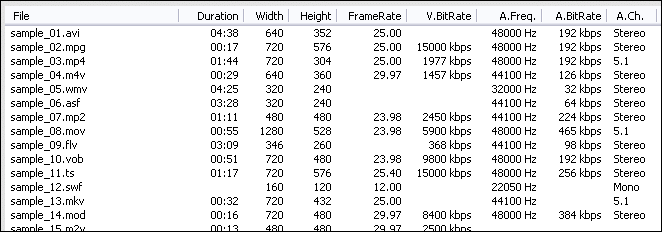
- Choose Output Format

Click on combo box of output format and then choose "to H.264".
- [Optional, for advanced user]
Set H.264 Encoding Parameters
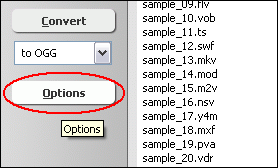
If you want to change H.264 encoding parameters such as bit rate, frame rate,
video size, and aspect ratio, please click "Options".
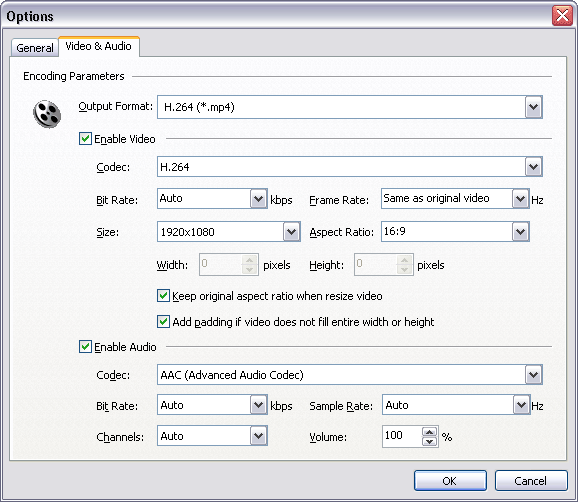
And then, switch to tab "Video & Audio" and choose "H.264
(*.mp4)" at "Output Format", and then set options for
video and audio.
- Convert OGG to H.264
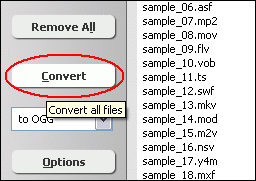
Click "Convert" to convert all OGG files in list to H.264 format.

The software is converting OGG files to H.264.
- Play & Browse
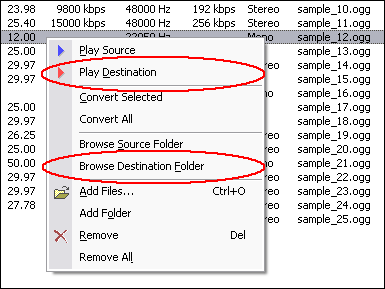
When conversion completes, you can right-click converted item and choose "Play
Destination" to play the outputted H.264 file; or choose "Browse
Destination Folder" to open Windows Explorer to browse the outputted H.264
file.
- Done
Top
OGG to H.264 Converter Software is 100% clean and safe to
install. It's certified by major download sites.

Convert OGG to H.264 Related Topics:
|











